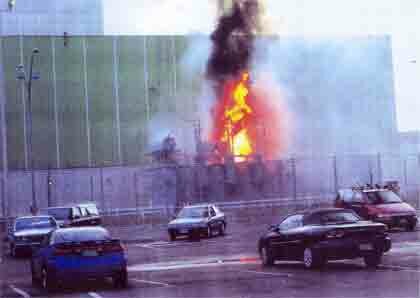Crea Lintilhac on the aging Vermont Yankee nuclear power plant’s threat to New England
Listen Now Download the show by right-clicking the link.
This week Dr. Calidcott talks about the aging Vermont Yankee nuclear reactor with Crea Lintilhac of the Lintilhac Foundation in Vermont. In 2005, the Lintilhac Foundation celebrated 30 years of charitable giving in the areas of renewable energy, clean water and social justice. Lintilhac holds a Master’s Degree in Teaching in Geology from the University of Vermont, and she received an Honorary Doctor of Science degree from Middlebury College in 1998. She also serves as an officer and trustee of several environmental advocacy boards in Vermont.
Dr. Caldicott starts off by asking Lintilhac about the age of Vermont Yankee, recent problems at the plant, and where the state legislature stands. In her response, Lintilhac talks about how the plant is operating beyond capacity, and is in many ways “falling apart” as represented by fires at the site and the 2007 cooling tower collapse. Nuclear waste is another topic of this show, and Lintilhac and Dr. Caldicott explore the dangers of storing radioactive waste at Vermont Yankee and at the other 103 U.S. nuclear plants.
Dr. Caldicott remarks about her visit to the plant vicinity, when she saw the grade school across the street built by the nuclear utility that owns Vermont Yankee. Children, she notes, are far more sensitive to nuclear radiation, and nuclear plants constantly release toxic radiation in various forms. See links further down regarding the study led by Dr. Winfrid Eisenberg which found higher childhood cancer incidence near German nuclear plants.

Crea Lintilhac
Lintilhac underlines the serious danger of an accident or terrorist attack at the plant, which would have implications for not only Vermont but all of Massachusetts (whose border the plant sits on) and several neighboring states. She talks about how a major accident would destroy the Vermont economy. Next, Dr. Caldicott has Lintilhac talk about the role of spent fuel pools in a nuclear reactor. Lintilhac refers to a book by Barbara Moran, The Day We Lost the H-Bomb: Cold War, Hot Nukes, and the Worst Nuclear Weapons Disaster in History. She says Moran’s book illustrates why governments and the nuclear industry should not consider any technology, especially nuclear weapons and nuclear power, “fail safe.” Read how Hillary Clinton is expanding the role of nuclear power globally in India Ramps up Nuclear Power With Help From the United States. Dr. Caldicott asks what the Vermont legislature would do if there was a meltdown at Vermont Yankee, and the cooling pool busted, and winds carried the radiation away from the plant.
This episode also addresses how global warming and accompanying sea level rise is expected to flood many of the world’s coastal nuclear power plants (which rely on ocean water to cool their contents). See the Greenpeace report The impacts of climate change on nuclear power station sites. They both agree that nuclear power is contraindicated to help reduce global warming. See the article Confronting a False Myth of Nuclear Power: Nuclear Power Expansion is Not a Remedy for Climate Change. Also read Nuclear Power Can’t Be a Solution to Global Warming Precisely because of Global Warming.
Lintilhac explains why it will be impossible to safeguard nuclear waste for several thousand years while it continues to be radioactive and quite dangerous. Dr. Caldicott talks about the cynical work that anthropologists are now doing for the Department of Energy. At one point, Lintilhac mentions a German doctor who came to Vermont to advocate closing Vermont Yankee. This was Winfrid Eisenberg, M.D., Dr. Caldicott’s guest on the
October 19 program. Read about the findings of Dr. Eisenberg’s study. Lintilhac points to successes in retraining workers from the automobile or other industries to work in renewable energy, and says that nuclear plant workers should also be transferred into sustainable energy technologies. She says that the Vermont government will soon vote on whether to extend the license for Vermont Yankee or not. Read Uncertainty grows on Vermont Yankee future. Dr. Caldicott closes by lauding Lintilhac as an example of a U.S. citizen who is using the democratic process to make change.

Citizens opposing the Vermont Yankee plant at a 2001 security hearing (AP Photo/Jon-Pierre Lasseigne)
For more information on the tremendous hazards of nuclear energy, read Dr. Caldicott’s books Nuclear Power is
Not the Answer and Nuclear Madness. See her article The medical and economic costs of nuclear power. Listen to the two-hour program Voices From Three-Mile Island: An Oral History of America’s Near Catastrophic Nuclear Accident / 30th Anniversary Release: A Two-Hour Oral History Documentary (nationally broadcast on public radio). See the websites of the Nuclear Information & Resource Service and Beyond Nuclear. For more information on the struggle to close Vermont Yankee, visit the websites of Safe Power Vermont, Nuclear Free Vermont and the Vermont Yankee Decommissioning Alliance. And be sure to read the inspiring report Carbon-Free and Nuclear-Free: A Roadmap for U.S. Energy Policy.
